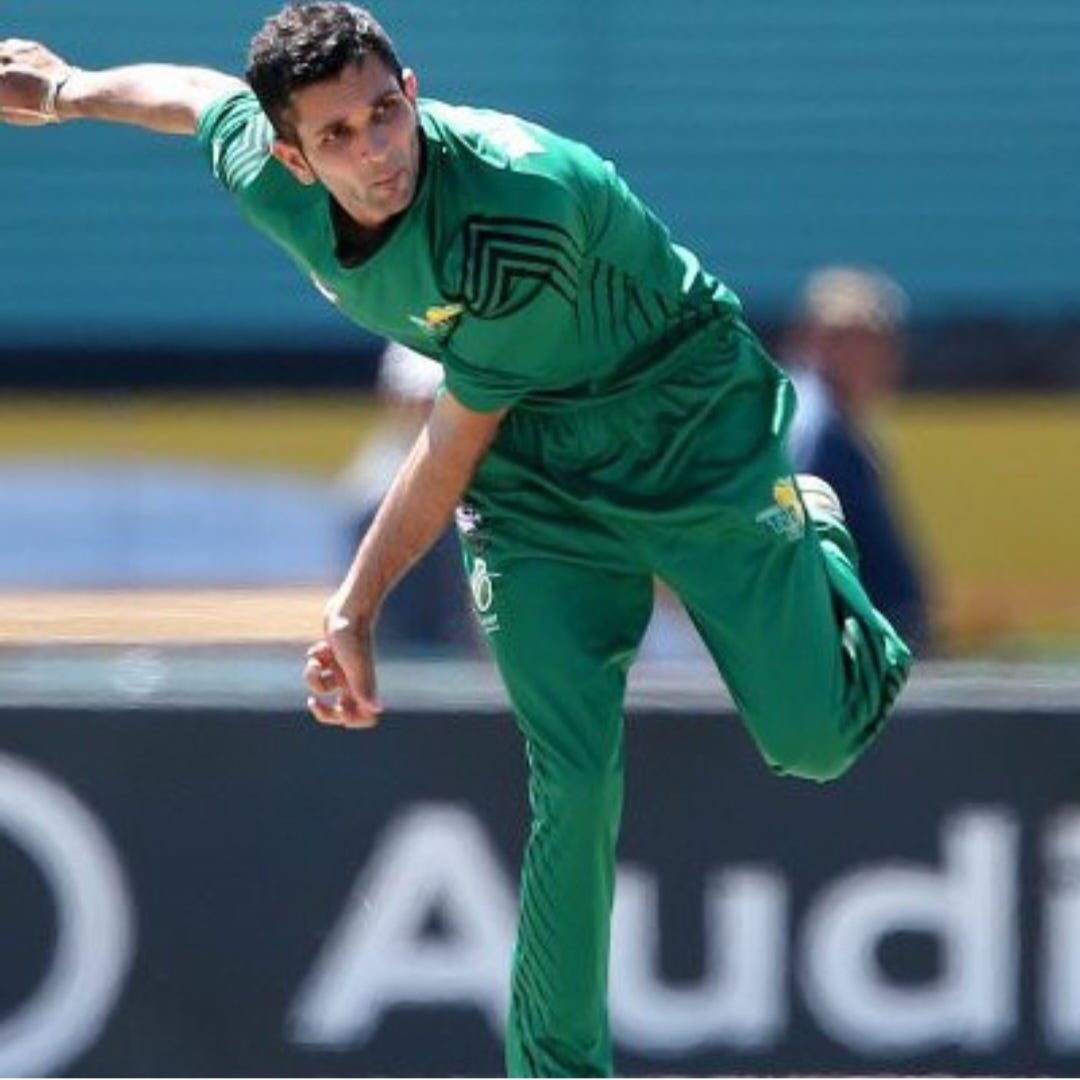Rewind to Number 1 of 171
Keshav Maharaj's journey to becoming South Africa's most successful spinner began in Australia.
Thank you for reading 438 & Beyond. If you like what you read, please click the button below, join the mailing list for FREE and share, on social media or through e-mail or however you feel comfortable sharing.
To support this project and keep things going, please consider becoming a Patron or buying a coffee.
Steve Smith stood his ground and asked Umpire Aleem Dar to send the decision upstairs to the third umpire. The Australian had danced down the track to a flat Keshav Maharaj delivery on middle and off. Smith meant to nudge the ball but missed, and was struck on the pads.
The South African players stood around Maharaj for an eternity while the third umpire, Richard Kettleborough, studied the footage. When he was done, the graphics showed two red lights and one orange. The ball had pitched just outside off, struck Smith in-line, and clipped the stumps. Maharaj had his maiden Test wicket.
If you had told him then that this was his first step towards becoming South Africa’s most successful spinner, he wouldn’t have believed you.
Legend has it that Kiran More looked at two-year-old Maharaj’s palms and predicted, "This child will be a cricketer."
It’s hard to know what the former Indian cricketer saw in the toddler’s palms, after all, he did not use an exact science. People in certain cultures look at a toddler’s palms to determine paternity. Maybe he just went off the fact that Maharaj’s palms resembled his father’s, Athmanand, a former first-class cricketer for Natal B.
Athmanand’s career didn’t peak in the lower leagues because he lacked talent and ability. Sport was segregated and this was as good as it got for him. That didn’t diminish his love for the game. When cricket opened up for everyone in the 1990s, Athmanand decided Maharaj would achieve what he had failed and More’s comment strengthened his resolve.
“My father bought me my first English willow bat when I was five years old and he spent a lot of time throwing balls to me,” Maharaj shared.
Despite growing up in an environment of cricket and making his debut for the Dolphins at 16, Maharaj’s path had its own challenges. He failed to cement a spot in the Dolphins side because he was overweight. In 2008, he made the KZN U19 side but was snubbed for the SA U19 team and was the first one to concede that it probably had to do with his size.
“I constantly failed yo-yo tests because I was on the large side,” Maharaj shared.
Lance Klusener, who coached the Dolphins at the time recalled that Maharaj could neither run, field, nor catch. “Kesh could bowl. He had a smooth action. You could sit and watch him bowl and think, what a waste because he can’t last a day. It was frustrating because he worked hard and had talent but it didn’t look like he could take his talent anywhere,” said Klusener.
At 22, Maharaj was ready to try a different path. He was tired of unsuccessfully trying to earn a spot in the first team. Athmanand asked for one last year of cricket from his son. The year after, he secured a spot as Cuckfield CC’s overseas pro. Before he left, Klusener asked him to lose 5 kg.
Maharaj didn’t just lose 5 kg during his time in the UK, he lost 17.5 kg and adopted a different perspective towards life. He was leaner, lighter and better.
“When he lost the weight, he could do more. His fielding improved and he worked on his batting,” Klusener said.
With the ball, he bagged 36 wickets at 29.38 in the 2014-15 4-day season. In 2015-16, he took the same number at 32. He then took 13 for 157 in the first match of the 2016-17 season. Not long after that haul, Maharaj received a call from Linda Zondi, the then-head of selectors, telling him to pack. He had been selected for the Proteas side going to Australia.
Normally, I ask you to support the newsletter, but at the moment, I have a bigger ask, if you can spare a little bit, please contribute to my son’s cancer treatment and recovery. Many people have been generous, but we have not yet reached the full amount required. You can also help by sharing the link:
“I still get goosebumps when I remember Hashim Amla capping me. It was a special moment receiving that cap, cap number 91. The next thing I remember is standing on the field singing the national anthem in front of 20-30,000 people. It was phenomenal,” Maharaj relived his debut.
Though he had gone to bed aware of an impending debut, nothing had prepared Maharaj for the emotions. Vernon Philander had let him know. Maharaj’s response to Philander’s information was shock and then denial. “When Vern asked me if I was ready, I told him I was on the tour to learn and carry drinks,” he shared.
Maharaj had held on to the dream of becoming South Africa’s greatest spinner from the day he adopted the craft, but he was also not naïve. He knew the difficulties of being a spinner in South African cricket.
Once upon a time, South Africa had the four legspinners of the apocalypse; Reggie Schwarz, Aubrey Faulkner, Bert Vogler and Gordon White. Their modern equivalent is a pace attack of Kagiso Rabada, Nandre Burger, Anrich Nortje and Lungi Ngidi. Schwarz learned from Bernard Bosanquet during his spell with Middlesex, and he in turn taught what he knew to Faulkner, Vogler and White.
Maharaj didn’t have a Bosanquet or a Schwarz to guide him. Besides Athmanand, who helped him convert from an aspiring pacer to a left-arm orthodox, Maharaj did not have specialist coaches. He had to figure things out on his own. It helped that he has always had a good work ethic.
“He was the first one to arrive and the last one to leave. His father would drop him off on his way to work and then pick him up on his way home after five. Kesh would spend hours in the nets bowling at cones. Sometimes he would replace cones with something smaller,” Klusener shared.
After the Schwarz-led quartet, South Africa had Hugh Tayfield. The Durbanite was probably the greatest spinner to ever bowl for South Africa. Tayfield is in the top 10 of the most effective spinners in the history of Test cricket. He was so good South Africa almost depended on him entirely between 1949 and 1960, so much so that he averaged 61 6-ball overs a match. Despite bowling so much, Tayfield averaged a mere 25.91.
When Maharaj made his debut, South African cricket was a world away from the Tayfield era where spinners played a central role. Spinners were considered an optional extra. They were dropped when the team needed a spot to slot in a pacer or batter. A batter who could spin the ball a bit had a better shot at selection than a frontline tweaker.
It was no place for a spinner with huge ambitions. Ask Paul Harris, who was asked to bowl dry and became an automaton. Or Robbie Peterson, who changed his action to become a ‘safe’ bowler. Or Tabraiz Shamsi who was barely given an opportunity. There is also Paul Adams, whose career ended at 31.
Maharaj’s career has followed the expected ‘spinner’s path’, for the most part. His stats show that he has played 87 Test innings, what they don’t show is that he has not been asked to bowl a single delivery in 10 of those innings and also delivered 10 or fewer overs in 25 innings.
“I didn’t know what to do with the first ball. I stood there for a moment looking at Shaun Marsh, who was ready to face my first delivery. Then something on my shoulder told me, ‘You belong here,’” Maharaj relived his first over.
His first delivery was slow and turning, targeted at off-stump. Marsh worked down to fine leg for two runs. Maharaj escaped his first over with little damage. He conceded four runs. His second was a trainwreck.
“David Warner was driving me and he scored 12 runs off my second over. It’s easy to feel disappointed when that happens, but Hashim was always clapping his hands to encourage me. I have always looked up to him, so his encouragement meant a lot. It kept me going,” Maharaj shared.
Maharaj’s two-over spell was at the end of day. The next morning, he found himself back in the attack sooner than he expected; Dale Steyn had injured his shoulder 16.4 overs into day 2.
“When Steyn left the field, I knew it was my job to hold up an end. So, I tried to bowl my best ball each time to make sure Australia didn’t run away with the game,” said Maharaj.
He did more than hold up an end. Maharaj took his maiden Test wicket with his 11th delivery of the morning. Seven years, nine months and two weeks later, he took his 171st Test wicket to overtake Tayfield’s 170 and become South Africa’s most successful spinner in the format.
There is no one ahead of him now. Maharaj is now setting the pace. Whatever number he finishes on will not be overtaken, given the way Test cricket is going.






